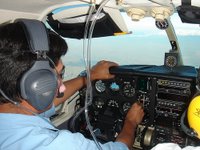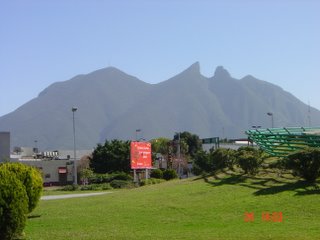New airplane and overconfident instructor: a bad combination

A friend recently bought a nice Cessna T182RG (Turbo 182 with retractable gear) and went to pick up the plane abouth 45 nautical miles from our homebase. He took a pilot he trusts, an FAA certified flight instructor (though he is mexican) that has lots of experience but none in this type of airplane... My friend himself is kind of new at aviation and has less than 300 hours on a Piper Cherokee 180. So it was a good idea to have an experienced instructor on-board. Or wasn´t it?
First takeoff:
The new owner (my friend) pushed the throttle forward and prepared to rotate. Being as careful as he is, he noticed and commented to the instuctor that the AI (airspeed indicator) seemed to be indicating anomalously. The instructor, probaly because he does not know the 182 very well, saw the needle move and overrided my friend´s assesment. An my friend succumbed to the higher experience... After all, in this new aircraft the instructor was the pilot in command.
First Landing (part 1):
Normal approach speed is selected and the instructor is performing the landing. 80 kts on final approach, high altitude airport (8,100 ft) and kind of a short runway for this altitude (3,500 ft). Temperature: 27C (around 81F)... To be continued.
Second takeoff... and second landing:
My friend, $1,100 USD poorer that the previous day was not very optimistic and confessed to be a bit intimidated by the aircraft. I told him that the 182 is one of the safest and easiest planes to fly and that he was going to be comfortable after a few hours in the plane. And off we went for our first familiarization flight. On taxiing I joked with him over the new set of tires and the not very fortunate first landing of the plane of the last afternoon, but he smiled only politely. Well I thought, no jokes today. But I kept trying on cheering him up. Warm up, runup and ready for take off. Since this airplane is turbocharged it accelerates very well, and we were waiting for the correct airspeed. And with no warning, at just under 40 kts the plane lifted eagerly and smoothly by itself. This sounded a bell in my brain and checked everything right away... Everything, exept the airspeed seemed and felt ok. I know this because I owned a C182 for three years during which I took it on several long trips. In any case the remaining runway was not adecuate to try (again) to abort the landing and stop since is kind of short and downhill. We were way too close to the cliff that limits our home airport. I decided to continue. Two seconds had elapsed. I told him to keep the nose down to accelerate, although by the behaviour of the plane told me that the airspeed was not correct. We departed the pattern at what the airspeed indicator said was 50 kts to troubleshoot and climbed to 2,000 agl.
My friend set cruise parameters to see he behaviour of the plane.
-This AI is not working correctly- he said. -This cannot be-. The needle was moving but refused to go beyond 80 kt even in high cruise.
-Ok- I said -look at the setting and the GPS. We should be doing 140 kts at this settings, and this is what the GPS is telling us anyway-.
-Rrrright- he responded. - your airplane!- he continued.
I looked at him for a second trying to make my mind if this was an opportunity for an emergency lesson. But immediatly decided againts it, this was a noble but still a high-performance, complex aircraft and this was only his second flight in it.
-I have the plane-. I concurred. My last check was to turn 180 and check the GPS speed to make sure we were not being fooled by the wind but no, the groundspeed was still 140 kts. There was no wind.
-Atizapan traffic, this is IFT returning to the pattern and... uh... gentelmen, I am going to bother you because I need to land on runway 22-. There were several 152´s on the pattern on school touch and goes, and I had just told them that I was going to land in the opposite direction. I did this because our 04-22 runway has a 5% slope and all takeoffs have to made on runway 04. You can land in that runway also, although twins prefer to land on the 22 for safety. This helps reducing the speed rapidly, and in this case it wold be an extra safety factor because I would have to ignore the indicated airspeed. This is a high altitude, high temperature airport.
-IRC on downwind is going to perform 360´s until runway is clear- said one of the instructors.
-IKT on base will be on 360´s until runway clear- said the one in another plane. And the rest followed with similar messages.
Everybody gave us preference with no questions. With experienced instuctors on board, they needed no other expanation from me but my request knowing right away that there was a reason for it. This is nice in the aviation community.
Back to the cockpit I thought that my friend was a very cool customer but he was silent.
-I am going to have to land by the seat of my pants- I said casually. -When on final please read me the GPS speeds-.
A much more animated "Ok" was his answer. I did not really need that, but using everything you have at your disposal is always a good idea and also, there is nothing more useless in a cockpit than a pilot-owner with nothing to do.
There is nothing spectacular about landing a plane with no airspeed indicator (though it has killed even airline crews) if you are current. It is also very important to know the plane because the unpredictability of events is both the interesting thing about aviation and the dangerous thing about aviation. At the end I did not have the benefit of GPS speed because being new to the Garmin 430, my friend kept fumbing with the low terrain indications that blocked the speed indications of the GPS. But I ignored that and came to a nice textbook landing. No fast, not slow, just a regular old full stall landing. Sure, you bet I am bragging...
First Landing (part 2):
The pilot-instructor performed the landing and made several mistakes that resulted in a thousand or so dollars in damage to the plane. No injuries but my friend told me they finished 3 feet from the edge of the cliff at the end of runway 22 with two blown tires and abroken wheel. And a very scared pilot-instructor.
The first mistake was made long before this first landing. I guess that being experienced at instucting, and believe me, he IS a good pilot, he thought a turbocharged 182 would pose no challenge to him. He has driven much more comples twins and singles. I do not know if he studied the POH (pilot operating handbook) of the plane but I hope so. In any case, not having had a checkout himself with an instructor familiar with the 182 started the chain of events. On rotation, my friend noticed the AI was not normal. The instructor, unfamiliar with the airplane could not tell the difference but decided to call it bully. My friend decided to go silent against experience. Something I hope he will not continue to do, no matter the hours of the other guy. He is relatively inexperienced but very careful and pays close attention to his airplane. They talk to you. Most of the times they scream about your mistakes in advance. But we do not always hear. And in this case the instructor was the noise in the communication. The second mistake was really a consequence of the first, and it was not noticing that the airspeed on approach could not be right. From the flight we made the following morning (also not knowing that the AI was malfunctioning) I know the AI was wrong for at least 30 kts. It is hard to believe that he thought the airspeed was correct because on crossing the threshold he was doing more than 110 kts and not the 80 kts he saw on the AI, something very high even for a twin like the Seneca or the 90 mph he uses on a Skymaster flown frequently by him. Third mistake: not going around when seeing that the plane was floating incredibly. The attitude of the plane should have been very flat in this moments and trying to land like this in a short, high-altitude downhill runway is inexcusable unless you do not have a working engine in front of you. The result was 3 feet from being catastrofic and a tribute to the engineering of the brakes and wheels in the plane. A brake designer somewhere has probably saved many lives in this way. Wherever you are, I salute you man! Fourth mistake: the worst from my point of view since the whole thing teached nothing to the instructor because he was not paying attention or did not care to understand exactly what had happened. The next day when we went flying the whole thing was rationalised as bas luck or bad wind. I have been trying to be merciful on this guy but the fact that my friend figured out the problem three seconds after we took off the next morning, makes mercy... inadecuate.
I realize I am being tough in judging the mistakes of a fellow pilot. But I permited myself this for two reasons: I strongly believe that if this particular pilot did not learn anything, the rest of us should. And avoid excuses and protagonism because "I am way past 1000 hours". Also, because I will grant the opportunity of critizising my own stupidity since my next writing is going to be about my own mistakes.
So, with my mind at ease, I have to say that maybe this is not fair, maybe it was just bad luck. But maybe being a thorough, procedural and responsible piot is not enough. Checklists cannot substitute a thinking pilot in command. You, the pilot, still have to think. And be honest about your own capabilities. No matter how much experience.
Ignore it, and it will bite you sooner or later.
Think-fly when you fly.


